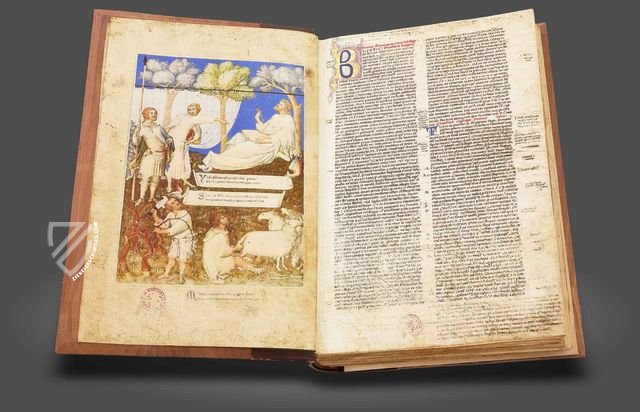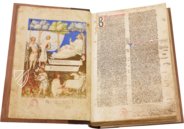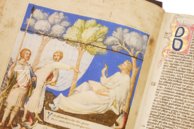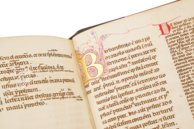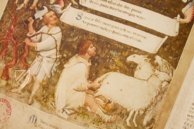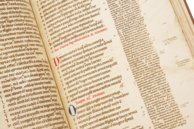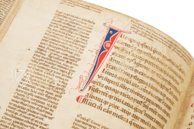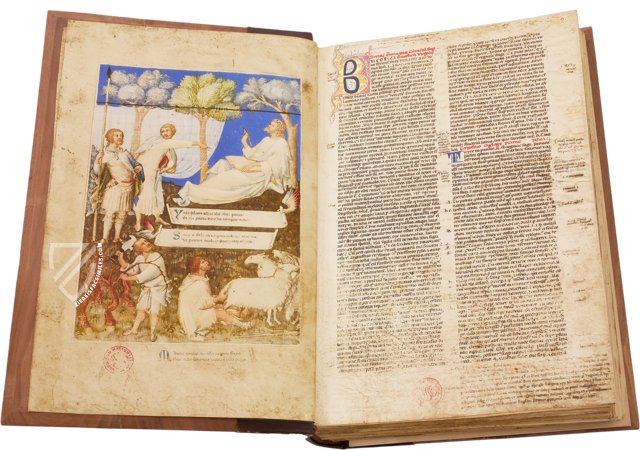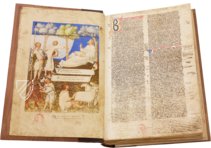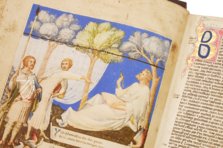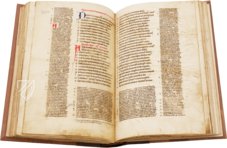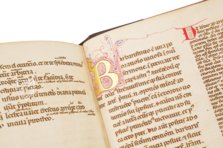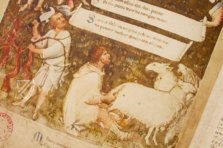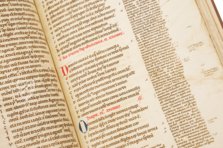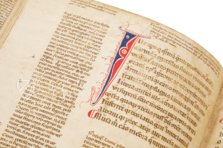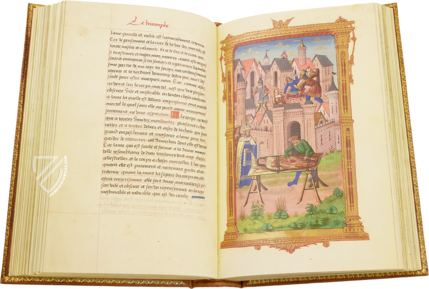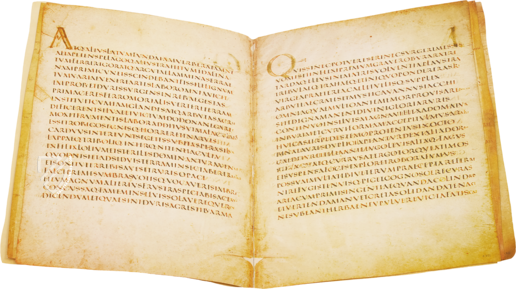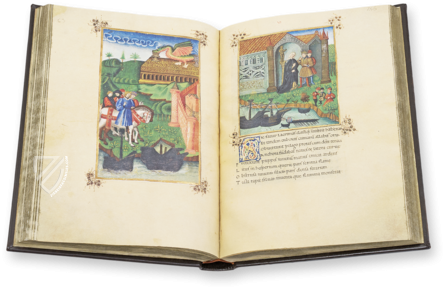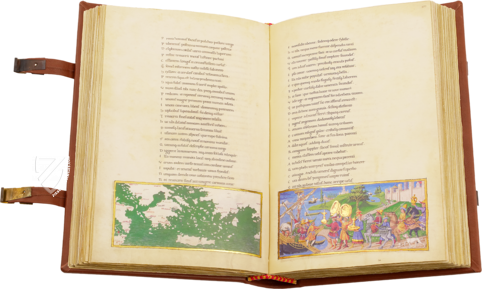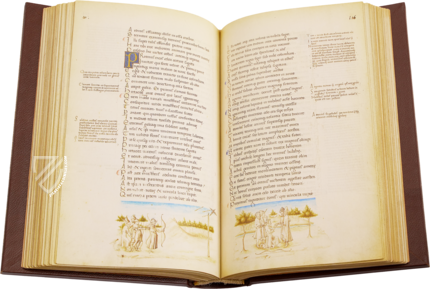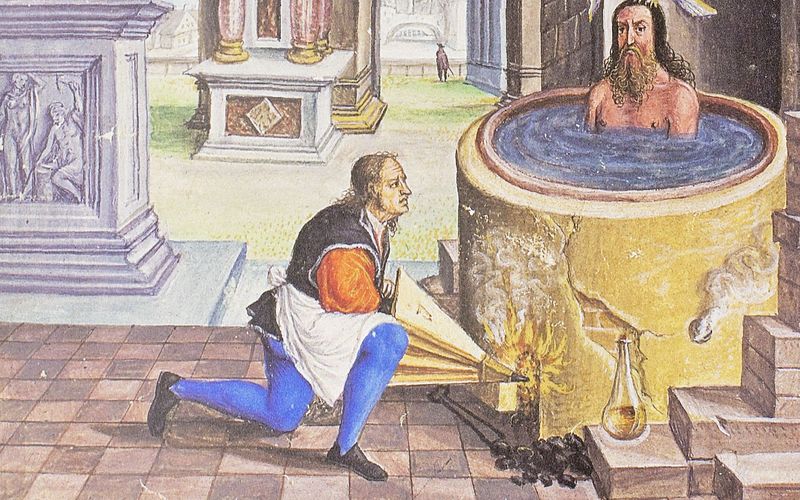Ambrosian Virgil of Francesco Petrarca
(1,000€ - 3,000€)
Aside from being a prolific author, Petrarch was also a bibliophile who amassed one of the finest private libraries of his day, which included many works from classical antiquity. The most famous manuscript in his library was the so-called Ambrosian Virgil, which contains the most important works by the famous Roman author as well as works by Publius Papinius Statius, Horace, and various grammatical works. Petrarch commissioned the work for his own use, and it was made in Avignon ca. 1300–25. However, the manuscript was soon stolen and Petrarch could not recover it until 1338. The manuscript is also famous for its allegorical frontispiece representing the Aeneid, Georgics, and Eclogues, which was created by his friend Simone Martini ca. 1340.
Ambrosian Virgil of Francesco Petrarca
This famous manuscript containing the principle works of the influential Roman poet Virgil (70–19 BC) was commissioned and owned by the humanist scholar Petrarch (1304–74) and furnished with a gorgeous frontispiece by the master painter Simone Martini. Additional texts include the commentaries of Servius as well as texts from Horace, Statius, and Donatus. As such, the specimen is a physical manifestation of the early Renaissance and the rediscovery of works from antiquity as well as an artifact from the lavish court of the Avignon Papacy. It is a coveted manuscript with a turbulent history that also gives insights into Petrarch’s personal life because he noted various events in the codex including the deaths of his son Giovanni and his beloved Laura.
Origins in Avignon
The text of the manuscript was written in Avignon during the first quarter of the 14th century and is adorned by blue and red initials as well as a large gold initial at the beginning of each work. Almost every page of the codex has a wide inner column and a narrow outer column: the wide one consists of Virgil's original text, the narrow Servius' commentary. However, the codex was stolen ca. 1325 before being recovered by Petrarch in 1338. During the meantime, the artist Simone Martini (c. 1284–1344) came to Avignon and found employment at the court of Pope Benedict XII (r. 1334–42), where he befriended Petrarch. Martini created a full-page miniature for the manuscript between 1338 and 1340, presumably as a gift for his friend. This manuscript also reflects the generous patronage of the arts at the decadent and worldly papal court in Avignon, which Petrarch referred to as the “Babylon of the West”.
Martini’s Magnificent Miniature
This fine full-page miniature is a testament both to Martini’s skills as an artist as well as his friendship with Petrarch. It is distinguished by a refined style with soft coloring, a wealth of naturalistic details, and is pregnant with symbolism. Servius, the Late Antique Roman grammarian and author of a series of commentaries on the works of Virgil, figuratively reveals the meaning of these works when he literally unveils the author by pulling back a curtain. A soldier, farmer, and shepherd serve as allegorical figures representing the respective themes of the Aeneid, Georgics, and Eclogues. All of the figures have unique and tremendously expressive faces while Servius gestures in an exaggerated manner.
A Turbulent History
After Petrarch’s death, the manuscript was bequeathed to Francesco da Carrara in Padua. When the city was conquered by Gian Galeazzo in 1388, it passed along with the rest of the Carraresi’s collections into the great Visconti-Sforza Library in Pavia. The manuscript was lent to Alessandro Sforza for twenty days in 1471 so that he could have it copied. After the defeat and capture of Ludovico Sforza, Pavia was occupied along with the rest of the Duchy of Milan by French forces in 1499 and the codex was supposed to be among 900 manuscripts that were brought back to France as plunder but was stolen once again by a certain patriotic Pavian named Antonio di Pirro. The manuscript found itself in Rome at the end of the 16th century until it was sold in the year 1600 by Cardinal Agostino Cusani to the Archbishop of Milan, Federico Borromeo, who purchased it on behalf of the Biblioteca Ambrosiana.
Codicology
- Alternative Titles
- Petrarca: Vergilianus-Codex
Francisci Petrarcae Vergilianus Codex
Virgilio ambrosiano - Size / Format
- 538 pages / 41.0 × 26.5 cm
- Origin
- Italy
- Date
- Ca. 1300–1325
- Epochs
- Style
- Genre
- Language
- Illustrations
- A masterful allegorical frontispiece as well as golden initials with fleuronnée ornamentation and countless blue and red initial majuscules
- Content
- Vergil's Bucolics, Georgics and Aeneid; Servius' exegesis; Statius' Achilleid including accessus and commentary; 4 odes by Horace (II 3, II 10, II 16, and IV 7) with the commentary of Pseudo-Acron and some medieval glosses; two exegeses of the third book
- Artist / School
- Simone Martini (ca. 1284–1344)
- Previous Owners
- Francesco da Carrara
Visconti Library at Pavia
Cardinal Federico Borromeo
Ambrosian Virgil of Francesco Petrarca
Introduction, the Achilleid
This unfinished epic poem by the Greco-Roman poet Statius presents the life of Achilles and is appended in the back of this manuscript with other Virgil-adjacent works including four odes by Horace. A burnished gold letter “M” with flourishes in red and blue ink introduces the opening lines of the poem, which constitute an invocation from the poet to the Muses and Apollo for inspiration. While the gods may have given Statius the inspiration to start the work, they did not bless him with the longevity to finish it and only one and a half books were completed by the time of his death ca. AD 96.
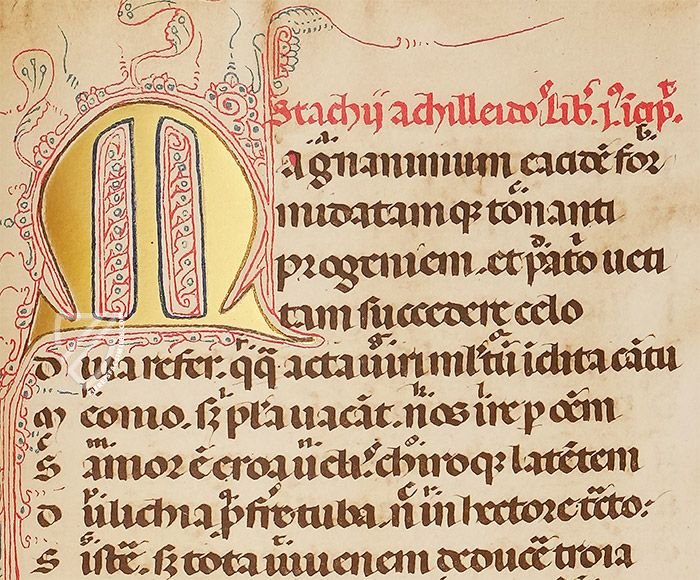
Ambrosian Virgil of Francesco Petrarca
Allegorical Frontispiece
This famous frontispiece was created by the Sienese master Simone Martini in 1340 and allegorically represents Virgil’s three major works. The ancient Roman poet leans up against a tree with a quill in his right hand while holding a book on his knees with his left as he gazes up into the sky as though searching for the right words. He is concealed behind a curtain that is both literally and metaphorically pulled back by the Late Antique Roman grammarian Servius, author of a series of commentaries on the works of Virgil.
Aeneas is depicted next to Servius leaning against a long spear and resting his hand on the hilt of a longsword, his blue cloak revealing a green lining and a red belt with a dagger. The farmer trimming vines with a billhook in the lower-left corner represents the Georgics while the shepherd milking a sheep next to him represents the Eclogues. In the center of the page, the two banderoles contain dedications to Virgil and Servius respectively.
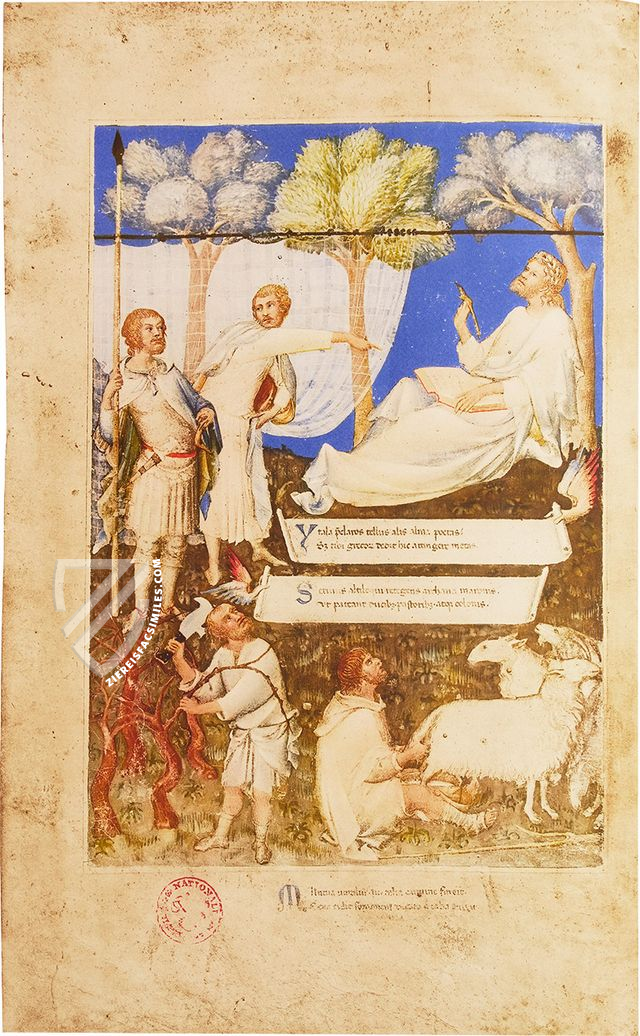
#1 Francisci Petrarcae Vergilianvs codex
Language: Italian
(1,000€ - 3,000€)
- Treatises / Secular Books
- Apocalypses / Beatus
- Astronomy / Astrology
- Bestiaries
- Bibles / Gospels
- Chronicles / History / Law
- Geography / Maps
- Saints' Lives
- Islam / Oriental
- Judaism / Hebrew
- Single Leaf Collections
- Leonardo da Vinci
- Literature / Poetry
- Liturgical Manuscripts
- Medicine / Botany / Alchemy
- Music
- Mythology / Prophecies
- Psalters
- Other Religious Books
- Games / Hunting
- Private Devotion Books
- Other Genres
- Afghanistan
- Armenia
- Austria
- Belgium
- Belize
- Bosnia and Herzegovina
- China
- Colombia
- Costa Rica
- Croatia
- Cyprus
- Czech Republic
- Denmark
- Egypt
- El Salvador
- Ethiopia
- France
- Germany
- Greece
- Guatemala
- Honduras
- Hungary
- India
- Iran
- Iraq
- Israel
- Italy
- Japan
- Jordan
- Kazakhstan
- Kyrgyzstan
- Lebanon
- Liechtenstein
- Luxembourg
- Mexico
- Morocco
- Netherlands
- Palestine
- Panama
- Peru
- Poland
- Portugal
- Romania
- Russia
- Serbia
- Spain
- Sri Lanka
- Sweden
- Switzerland
- Syria
- Tajikistan
- Turkey
- Turkmenistan
- Ukraine
- United Kingdom
- United States
- Uzbekistan
- Vatican City
- A. Oosthoek, van Holkema & Warendorf
- Aboca Museum
- Ajuntament de Valencia
- Akademie Verlag
- Akademische Druck- u. Verlagsanstalt (ADEVA)
- Aldo Ausilio Editore - Bottega d’Erasmo
- Alecto Historical Editions
- Alkuin Verlag
- Almqvist & Wiksell
- Amilcare Pizzi
- Andreas & Andreas Verlagsbuchhandlung
- Archa 90
- Archiv Verlag
- Archivi Edizioni
- Arnold Verlag
- ARS
- Ars Magna
- ArtCodex
- AyN Ediciones
- Azimuth Editions
- Badenia Verlag
- Bärenreiter-Verlag
- Belser Verlag
- Belser Verlag / WK Wertkontor
- Benziger Verlag
- Bernardinum Wydawnictwo
- BiblioGemma
- Biblioteca Apostolica Vaticana (Vaticanstadt, Vaticanstadt)
- Bibliotheca Palatina Faksimile Verlag
- Bibliotheca Rara
- Boydell & Brewer
- Bramante Edizioni
- Bredius Genootschap
- Brepols Publishers
- British Library
- C. Weckesser
- Caixa Catalunya
- Canesi
- CAPSA, Ars Scriptoria
- Caratzas Brothers, Publishers
- Carus Verlag
- Casamassima Libri
- Centrum Cartographie Verlag GmbH
- Chavane Verlag
- Christian Brandstätter Verlag
- Circulo Cientifico
- Club Bibliófilo Versol
- Club du Livre
- CM Editores
- Collegium Graphicum
- Collezione Apocrifa Da Vinci
- Comissão Nacional para as Comemorações dos Descobrimentos Portugueses
- Coron Verlag
- Corvina
- CTHS
- D. S. Brewer
- Damon
- De Agostini/UTET
- De Nederlandsche Boekhandel
- De Schutter
- Deuschle & Stemmle
- Deutscher Verlag für Kunstwissenschaft
- DIAMM
- Droz
- E. Schreiber Graphische Kunstanstalten
- Ediciones Boreal
- Ediciones Grial
- Ediclube
- Edições Inapa
- Edilan
- Editalia
- Edition Deuschle
- Edition Georg Popp
- Edition Leipzig
- Edition Libri Illustri
- Editiones Reales Sitios S. L.
- Éditions de l'Oiseau Lyre
- Editions Medicina Rara
- Editorial Casariego
- Editorial Mintzoa
- Editrice Antenore
- Editrice Velar
- Edizioni Edison
- Egeria, S.L.
- Eikon Editores
- Electa
- Emery Walker Limited
- Enciclopèdia Catalana
- Eos-Verlag
- Ephesus Publishing
- Ernst Battenberg
- Eugrammia Press
- Extraordinary Editions
- Fackelverlag
- Facsimila Art & Edition
- Facsimile Editions Ltd.
- Facsimilia Art & Edition Ebert KG
- Faksimile Verlag
- Feuermann Verlag
- Folger Shakespeare Library
- Franco Cosimo Panini Editore
- Friedrich Wittig Verlag
- Fundación Hullera Vasco-Leonesa
- G. Braziller
- Gabriele Mazzotta Editore
- Gebr. Mann Verlag
- Gesellschaft für graphische Industrie
- Getty Research Institute
- Giovanni Domenico de Rossi
- Giunti Editore
- Graffiti
- Grafica European Center of Fine Arts
- Guido Pressler
- Guillermo Blazquez
- Gustav Kiepenheuer
- H. N. Abrams
- Harrassowitz
- Harvard University Press
- Helikon
- Hendrickson Publishers
- Henning Oppermann
- Herder Verlag
- Hes & De Graaf Publishers
- Hoepli
- Holbein-Verlag
- Houghton Library
- Hugo Schmidt Verlag
- Idion Verlag
- Il Bulino, edizioni d'arte
- ILte
- Imago
- Insel Verlag
- Insel-Verlag Anton Kippenberger
- Instituto de Estudios Altoaragoneses
- Instituto Nacional de Antropología e Historia
- Istituto dell'Enciclopedia Italiana - Treccani
- Istituto Ellenico di Studi Bizantini e Postbizantini
- Istituto Geografico De Agostini
- Istituto Poligrafico e Zecca dello Stato
- Italarte Art Establishments
- Jan Thorbecke Verlag
- Johnson Reprint Corporation
- Josef Stocker
- Josef Stocker-Schmid
- Jugoslavija
- Karl W. Hiersemann
- Kasper Straube
- Kaydeda Ediciones
- Kindler Verlag / Coron Verlag
- Kodansha International Ltd.
- Konrad Kölbl Verlag
- Kurt Wolff Verlag
- La Liberia dello Stato
- La Linea Editrice
- La Meta Editore
- Lambert Schneider
- Landeskreditbank Baden-Württemberg
- Leo S. Olschki
- Les Incunables
- Liber Artis
- Library of Congress
- Libreria Musicale Italiana
- Lichtdruck
- Lito Immagine Editore
- Lumen Artis
- Lund Humphries
- M. Moleiro Editor
- Maison des Sciences de l'homme et de la société de Poitiers
- Manuscriptum
- Martinus Nijhoff
- Maruzen-Yushodo Co. Ltd.
- MASA
- Massada Publishers
- McGraw-Hill
- Metropolitan Museum of Art
- Militos
- Millennium Liber
- Müller & Schindler
- Nahar - Stavit
- Nahar and Steimatzky
- National Library of Wales
- Neri Pozza
- Nova Charta
- Oceanum Verlag
- Odeon
- Orbis Mediaevalis
- Orbis Pictus
- Österreichische Staatsdruckerei
- Oxford University Press
- Pageant Books
- Parzellers Buchverlag
- Patrimonio Ediciones
- Pattloch Verlag
- PIAF
- Pieper Verlag
- Plon-Nourrit et cie
- Poligrafiche Bolis
- Presses Universitaires de Strasbourg
- Prestel Verlag
- Princeton University Press
- Prisma Verlag
- Priuli & Verlucca, editori
- Pro Sport Verlag
- Propyläen Verlag
- Pytheas Books
- Quaternio Verlag Luzern
- Reales Sitios
- Recht-Verlag
- Reichert Verlag
- Reichsdruckerei
- Reprint Verlag
- Riehn & Reusch
- Roberto Vattori Editore
- Rosenkilde and Bagger
- Roxburghe Club
- Salerno Editrice
- Saltellus Press
- Sandoz
- Sarajevo Svjetlost
- Schöck ArtPrint Kft.
- Schulsinger Brothers
- Scolar Press
- Scrinium
- Scripta Maneant
- Scriptorium
- Shazar
- Siloé, arte y bibliofilia
- SISMEL - Edizioni del Galluzzo
- Sociedad Mexicana de Antropología
- Société des Bibliophiles & Iconophiles de Belgique
- Soncin Publishing
- Sorli Ediciones
- Stainer and Bell
- Studer
- Styria Verlag
- Sumptibus Pragopress
- Szegedi Tudomànyegyetem
- Taberna Libraria
- Tarshish Books
- Taschen
- Tempus Libri
- Testimonio Compañía Editorial
- Thames and Hudson
- The Clear Vue Publishing Partnership Limited
- The Facsimile Codex
- The Folio Society
- The Marquess of Normanby
- The Richard III and Yorkist History Trust
- Tip.Le.Co
- TouchArt
- TREC Publishing House
- TRI Publishing Co.
- Trident Editore
- Tuliba Collection
- Typis Regiae Officinae Polygraphicae
- Union Verlag Berlin
- Universidad de Granada
- University of California Press
- University of Chicago Press
- Urs Graf
- Vallecchi
- Van Wijnen
- VCH, Acta Humaniora
- VDI Verlag
- VEB Deutscher Verlag für Musik
- Verlag Anton Pustet / Andreas Verlag
- Verlag Bibliophile Drucke Josef Stocker
- Verlag der Münchner Drucke
- Verlag für Regionalgeschichte
- Verlag Styria
- Vicent Garcia Editores
- W. Turnowski Ltd.
- W. Turnowsky
- Waanders Printers
- Wiener Mechitharisten-Congregation (Wien, Österreich)
- Wissenschaftliche Buchgesellschaft
- Wissenschaftliche Verlagsgesellschaft
- Wydawnictwo Dolnoslaskie
- Xuntanza Editorial
- Zakład Narodowy
- Zollikofer AG

